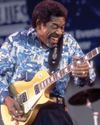
The Mixolydian mode dates back to around 700BC and the music of the ancient Greeks. In its modern-day form Mixolydian is the perfect scale or mode for creating beautiful melodies, lush chords, and harmonically sophisticated solos. But what exactly is the Mixolydian mode and where does it come from?
The starting point for any Major mode is the Major scale itself. Ascend one octave from C to C (corresponding to the white keys on a piano) and you will produce the familiar sound of the C Major scale (the ‘do-re-me-fa so-la-ti-do’ scale). But what if you were to ascend an octave, still using the notes of the C Major scale, but this time starting and ending on a different note? This results in a different structure of tones and semitones so create an entirely new scale form. The six intervals of C Major produce six different modes, in the order, they are D Dorian, E Phrygian, F Lydian, G Mixolydian, A Aeolian and B Locrian. We’re focusing on the fifth mode in this lesson, which is our Mighty Mixolydian. So let’s take a look under the hood and examine the engine: the DNA of what is arguably the most important of all the Major modes.
この記事は Guitar Techniques の April 2020 版に掲載されています。
7 日間の Magzter GOLD 無料トライアルを開始して、何千もの厳選されたプレミアム ストーリー、9,000 以上の雑誌や新聞にアクセスしてください。
すでに購読者です ? サインイン
この記事は Guitar Techniques の April 2020 版に掲載されています。
7 日間の Magzter GOLD 無料トライアルを開始して、何千もの厳選されたプレミアム ストーリー、9,000 以上の雑誌や新聞にアクセスしてください。
すでに購読者です? サインイン

THE MOODY BLUES
This month Stuart Ryan delves into the picking style of this British prog legend whose acoustic guitar has powered many a Moody Blues song.

WAYNE KRANTZ
This issue Nick Mellor provides an insight into this brilliant jazz stylist, focusing on his approach to improvising over static chords.

OPEN G TUNING
Open tunings are great fun and can help create exciting new ideas. Simon Barnard shows how to incorporate open G tuning into your playing.

RODRIGO GOUVEIA
Last month we featured Mateus Asato, and mentioned the importance of the neo-soul style in his playing. Here we turn to his fellow Brazilian, the master of neo-soul fusion.

MARK KNOPFLER
Our topic this month is a master craftsman as both guitar player and songwriter. His style is unique and his influence spreads far and wide.

U2
Martin Cooper checks out the chiming pedal delay tones of this stadium-filling band from Dublin, Ireland, and guitarist The Edge.

LUTHER ALLISON
It’s blues with a touch of soul this month, as David Gerrish explores the dynamic, expressive style of an often overlooked Chicago bluesman.

JOHANN KASPAR MERTZ Capriccio
This month Declan Zapala explores the music of Austria at the turn of the Romantic period with a fiery caprice to level up your fingers and unlock your inner virtuoso.

THE CROSSROADS Michael Landau
John Wheatcroft explores the playing of a session ace _ and blazing blues-rock maestro who graces the top-flight m band of singer-songwriting legend, James Taylor.

VIDEO MASTERCLASS Troy Redfern
This month GT welcomes this slide guitar virtuoso. If you've been wanting to take your slide playing to the next level then this is one's for you. With Jon Bishop.